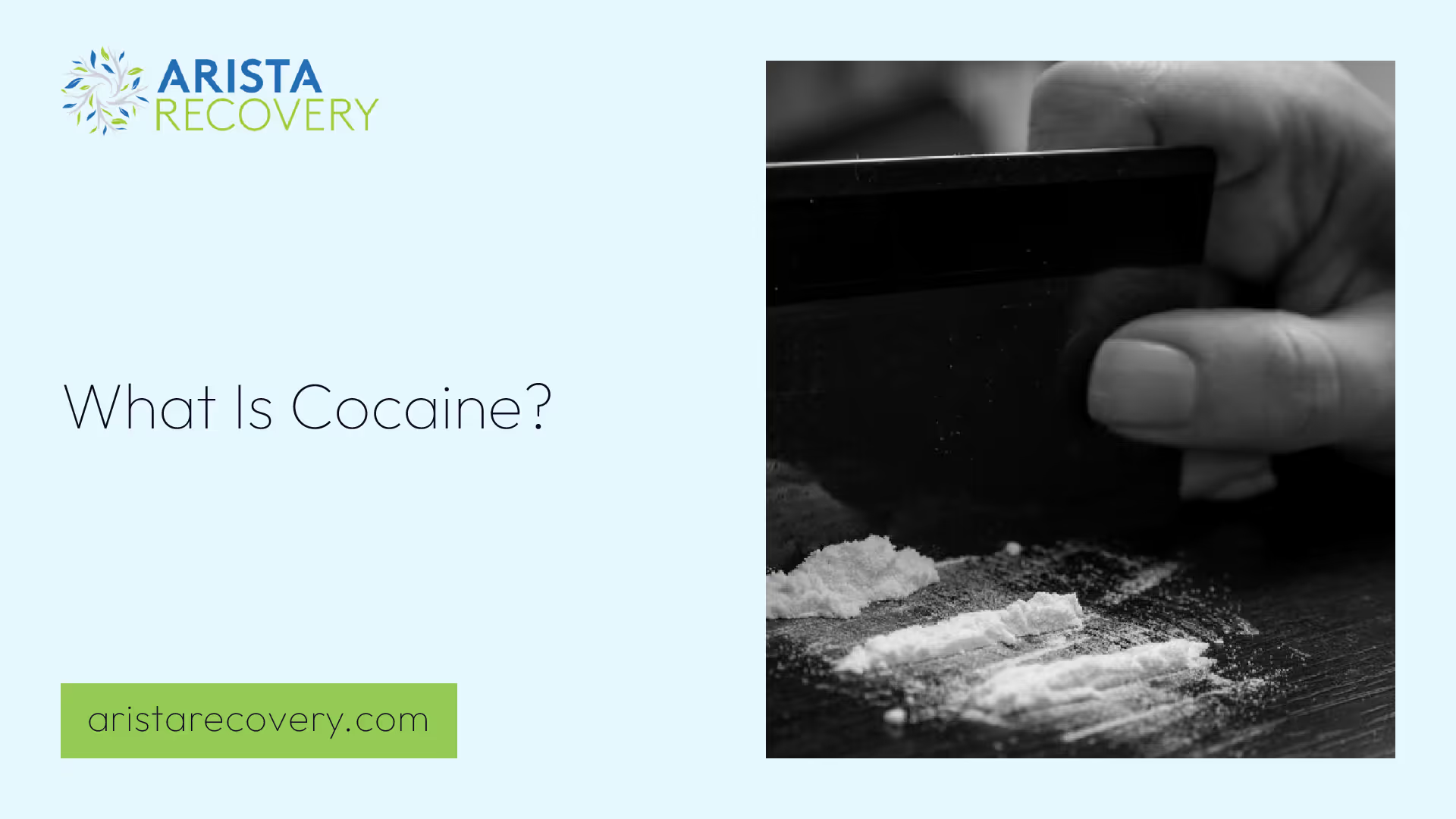What Is Cocaine?

Understanding Cocaine
Cocaine, a powerful stimulant drug with a controversial history and significant societal impact, is often a focal point in discussions about drug misuse and addiction. To truly understand the 'what is cocaine?' question, it's important to delve into the origins of the substance and its medical history.

Origins of Cocaine
Cocaine is derived from the coca plant, which originates in the Andean highlands of South America. The plant has been utilized for thousands of years before the arrival of European colonizers, with indigenous people using the coca leaves as a stimulant [1].
These leaves were also employed for medicinal purposes, including the alleviation of upset stomach, nausea, altitude sickness, and hunger. In addition to their stimulant properties, the leaves contain nutrients, making them a source of energy and vitamins for users.
The cultivation of the coca bush is most prominent in Colombia, which was responsible for the majority of the 1,410 tons of cocaine produced in 2016. The global area under coca bush cultivation totalled 213,000 hectares in the same year, marking a 25% increase from the previous year.
Medical History of Cocaine
The pure chemical of cocaine hydrochloride was first extracted in the mid-1900s and initially used for medical and legal recreational purposes. It was even found in the original formulation of Coca-Cola, although it was phased out starting in 1903. However, Coca-Cola still contains non-narcotic coca leaf extract for flavoring.
Misuse of purified cocaine as a central nervous system (CNS) stimulant began in the early years of the twentieth century. Despite its potential for addiction and the significant health risks associated with its use, cocaine continues to be misused worldwide, contributing to significant public health issues.
The history and origins of cocaine provide context for the ongoing discussions about the drug. Its initial uses in medicine and its role in the creation of a globally popular beverage contrast sharply with the destructive impact it can have on individuals and societies when misused. This dichotomy underscores the complexity of the issues surrounding cocaine.
Street Names and Mixtures
In the context of understanding what cocaine is, it's important to be aware of the various street names and mixtures that are often associated with this substance. The street names for cocaine are diverse and constantly evolving, and there are various common names for cocaine mixed with other substances.
Common Street Names for Cocaine
Street names for cocaine often reflect the effects of the drug, its appearance, or its origin. These nicknames can be derived from the South American coca plant, from which cocaine is derived.
Common street names for cocaine include:
- Snow
- Rock
- Blow
- Coke
- Dust
- Flake
This list is not exhaustive, as new slang terms can emerge at any time.
Cocaine Mixed with Other Drugs
Cocaine is often mixed with other drugs to produce varying effects. These mixtures are known by different street names, depending on the substances involved. For example, cocaine mixed with marijuana is referred to as "Bazooka" or "Candy Sticks", while cocaine mixed with heroin is known as "Beach", "Belushi", or "Speedball". Other mixtures include cocaine with PCP (known as "Space", "Whack", or "Space Dust"), with meth (referred to as "Croak"), with tobacco (called "Coolie" or "Geek-Joint"), and a combination of heroin, meth, benzos, and alcohol (known as "Five way") [4].
In addition to being mixed with other drugs, cocaine is also frequently cut with diluting agents like cornstarch, talcum powder, baking soda, or flour to stretch batches for increased profits. More dangerously, dealers sometimes cut cocaine with substances like fentanyl to enhance effects, leading to a rise in overdose deaths.
As the risks associated with cocaine use are greatly amplified when the drug is mixed with other substances, understanding these mixtures and their associated street names is crucial in the context of public health and safety.
Immediate and Short-Term Effects
To gain a comprehensive understanding of what cocaine is, it is essential to consider both the behavioral and physical changes that occur in the short term after use. These effects can be wide-ranging and significantly impact a person's well-being.
Behavioral Changes from Cocaine Use
Cocaine use prompts a variety of behavioral changes. Users often experience a heightened sense of alertness and energy, which can lead to restlessness and anxiety. This hyperactive state is often accompanied by hypersensitivity to sight, sound, and touch. These effects can cause the user to behave erratically or impulsively, often leading to poor decision-making or risky behaviors.
Physical Effects of Cocaine
The physical effects of cocaine use are profound and can be quite dangerous. Immediately after consumption, cocaine can cause stomach pain, reduced appetite, nausea, vomiting, and constipation. These symptoms occur as a result of constricted blood vessels disrupting blood flow in the body.
One of the most immediate and dangerous effects of cocaine use is a rapid increase in heart rate and blood pressure. This sudden spike can elevate the risk of a heart attack, even in individuals who are otherwise healthy. Additionally, cocaine use leads to dilated pupils, which can cause sensitivity to light and blurred vision.
These immediate and short-term effects of cocaine use can be severe, leading to significant health risks. It's important to understand the dangers associated with cocaine use, as these initial effects can quickly escalate into long-term health complications if use continues. Understanding these risks can help individuals make informed decisions about their health and well-being.
Long-Term Impact on Health
When discussing the long-term impact of cocaine, it's essential to understand the serious health consequences, specifically the cardiovascular and respiratory effects of prolonged use.
Cardiovascular Effects of Cocaine
Cocaine can have severe cardiovascular effects, particularly with chronic use. The drug can increase the risk of blood clots, leading to serious conditions like heart attacks, pulmonary embolisms, strokes, and deep vein thrombosis.
The increased risk of these conditions is due to cocaine's effect on the body's ability to form blood clots. Additionally, cocaine raises heart rate and blood pressure, which can lead to damage to the heart's muscle and blood vessels.
Respiratory Consequences of Cocaine Use
Respiratory issues are another significant health concern linked to the long-term use of cocaine. Cocaine can result in a loss of sense of smell, nosebleeds, problems swallowing, and overall irritation of the nasal septum.
Smoking cocaine can further exacerbate these issues by preventing oxygen from entering the bloodstream. This leads to a higher risk of conditions such as pneumonia, acute respiratory distress, and asthma [6].
Understanding the long-term health impacts of cocaine use can provide a clearer picture of the severity of this drug's effects. It's essential to remember these consequences when discussing what cocaine is and the risks associated with its use.
Cognitive and Organ Damage
Continuous cocaine consumption can lead to significant cognitive impairment and organ damage. By understanding these adverse effects, it becomes clear why it's crucial to educate individuals about the dangers of this substance.
Cognitive Impairment from Cocaine
Chronic cocaine use can severely impair cognitive functions. According to the Priory Group, this impairment can affect several mental processes such as an individual's attention span, impulse inhibition, decision making, and motor skills. Furthermore, cocaine use can age the brain, leading to long-term memory problems.
Moreover, the DEA Museum mentions that cocaine can alter the growth of new neurons in the hippocampus region of the adult brain. This region is linked with learning, memory processes, and the regulation of stress and mood. By interfering with the process of new neuron growth, cocaine can impact significant factors in driving addictive behaviors, such as learning, memory, stress regulation, and mood.
Organ Damage Caused by Cocaine
In addition to cognitive impairment, cocaine can also cause significant organ damage, particularly to the kidneys and liver. According to the Priory Group, chronic or acute cocaine use can lead to severe complications for the kidney as muscle fibers die and the contents enter the bloodstream. This can potentially cause rhabdomyolysis, a condition characterized by muscle damage. The toxicity of cocaine as it metabolizes can also significantly injure the liver.
The American Addiction Centers further shares that chronic cocaine abuse can damage the kidneys due to permanently increased blood pressure. This can lead to kidney damage from loss of blood flow and can result in kidney failure due to rhabdomyolysis.
Overall, the damaging effects of cocaine on both cognitive function and organ health highlight the significant risks associated with this substance. The harmful health impacts further underscore the importance of public awareness and education about cocaine and other illicit substances.
Societal Impact and Current Trends
Understanding the societal impact and current trends of cocaine use gives crucial insight into the broader implications of this substance. This section will explore the historical evolution of cocaine use and its current status in society.
Historical Evolution of Cocaine Use
Cocaine, initially used in Western medicine as an anesthetic due to its numbing ability, was commonly used until the early 1900s. However, its medical usage declined due to the discovery of its addictive properties. The substance later reemerged in the 1970s as an expensive, high-status drug, leading to increased usage in the United States when it became more widely available and cheaper.
The market for cocaine expanded in the 1970s and 1980s, leading to the emergence of crack cocaine, a cheaper form more accessible to low-income individuals [8]. This widespread availability fueled a cycle of poverty, gang violence, and addiction, drastically affecting communities.
By the mid-1980s, the price of cocaine dropped steadily, leading to six million Americans using it regularly. However, its highly addictive and dangerous nature was rediscovered, especially highlighted by the death of college basketball star Len Bias in June 1986. This tragic event led to increased awareness about its negative impacts.
Current Status of Cocaine Abuse
Despite the historical prevalence of its use, the general use of cocaine appears to be on the decline today. However, it's important to note that approximately 1.4 million Americans still struggle with cocaine abuse and addiction, according to the National Survey on Drug Use and Health [8].
The production and trafficking of cocaine remain a significant issue, with Colombia producing 70 to 80 percent of the world's cocaine. This generates an estimated 400 million dollars’ worth of cocaine weekly, mainly from locally grown coca plants and imported cocaine base from Peru and Bolivia. Drug cartels in Colombia control almost all cocaine trafficking activities, shipping the drug to various parts of the world [7].
Understanding the history and current trends of cocaine use is crucial in addressing the issue. Awareness about the societal impact of cocaine and the dangers associated with its use is vital in combating the abuse and addiction of this potent drug.
References
[1]: https://americanaddictioncenters.org/blog/cocaine-slang-names
[2]: https://deserthopetreatment.com/stimulants/cocaine-addiction/how-its-made/
[3]: https://www.emcdda.europa.eu/publications/drug-profiles/cocaine_en
[4]: https://www.thehopehouse.com/cocaine-addiction/related/slang-for-cocaine/
[5]: https://delamere.com/addiction-treatment/drugs/cocaine-addiction/effects
[6]: https://www.priorygroup.com/blog/the-short-and-long-term-effects-of-cocaine-on-the-body
[7]: https://museum.dea.gov/exhibits/online-exhibits/cannabis-coca-and-poppy-natures-addictive-plants/coca
[8]: https://americanaddictioncenters.org/blog/cocaine-slang-names/
You’re not alone in this.
When mental health challenges and addiction intersect, it can feel isolating. At Arista, we offer compassionate, evidence-based, and trauma-informed care to help you heal, grow, and move forward.
You’re not alone in this.
When mental health challenges and addiction intersect, it can feel isolating. At Arista, we offer compassionate, evidence-based, and trauma-informed care to help you heal, grow, and move forward.
Support that moves with you.
You’ve taken a brave first step. At Arista Recovery, we’re here to help you continue with best-in-class care designed for long-term healing and support.
.webp)






